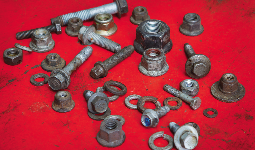 We’re all familiar with good ol’ split lock and star/toothed washers, as well as fastener alternatives like self-locking nuts. And we know that the performance of various types of lock washers and nuts over the years has been adequate, but not typically exceptional.
We’re all familiar with good ol’ split lock and star/toothed washers, as well as fastener alternatives like self-locking nuts. And we know that the performance of various types of lock washers and nuts over the years has been adequate, but not typically exceptional.
As times have changed, so has the technology available. In today’s challenging and competitive environment, wise shop owners and technicians take advantage of the most current improvements in products and procedures to enhance productivity and profitability.
Enter Threadlockers
Chemical threadlockers have seen greatly increased use in recent years, both on assembly lines and in service bays. According to Nick Seferi, product manager for Permatex, advances in chemistry have made threadlockers more versatile than ever before, and are able to meet a wide variety of fastening needs.
The most significant benefit of chemical threadlockers is that they provide better torque retention than mechanical methods. Lock washers only provide holding strength at the point of contact, whether it is under the head of the bolt or at the nut. They can lose their elasticity due to heat, vibration and time and cause the fastener to loosen.
Chemical threadlockers work differently. They fill in the spaces between the male and female threads and harden into a tough plastic that locks the entire fastener in place. This not only prevents vibration loosening, but also seals out moisture, dirt and other contaminants that can cause corrosion and compromise the integrity of the assembled joint.
“In addition,” observes Seferi, “gaskets can compress over time, which can compromise the torque retention of lock washers. Similarly, soft materials like aluminum and other alloys, and even the plastic-like materials used in today’s vehicles, can compress over time. This can make lock washers less effective and reduce the reliability of the clamped joint.”
Size Does Matter
“Innovations in threadlocker chemistry have allowed us to develop different formulations to fit a wide variety of fastener sizes and types in many applications,” explains Seferi. Four key factors that technicians need to consider to make the right threadlocker choice are: the size of the fastener; the torque specification; the nature of the parts being assembled; and the expected need for future disassembly.
For example, bolts used on water pumps or other accessories may only be 5/16” or M8, so the torque spec for such fasteners would be a modest 20 ft.-lbs., which is about 27 Nm. A water pump is something that can be expected to be replaced once or even several times in the life of a vehicle, so a medium-strength threadlocker would be a good choice for the attaching bolts.
On the other hand, a structural fastener on a truck chassis might be 3/4” or even an inch in diameter, and is unlikely to be removed during the normal life of the vehicle. So a high-strength threadlocker coincides with the larger bolt and the more permanent life expectancy of the assembled joint.
It’s important to note that, while a high-strength threadlocker does its job very well, disassembly will likely require special tools, procedures, and perhaps heat as well, where assemblies using low- and medium-strength threadlockers typically require only everyday hand tools for disassembly.
Here are some general guidelines to help technicians choose the best threadlocker for particular tasks:
Low-strength threadlocker — Commonly used for fuel injection and carburetor fasteners, relay lock screws and body panel mounting fasteners. Typically for fasteners up to 1/4” or 6 mm.
Medium-strength threadlocker — A good choice for oil pan fasteners, timing covers, starter and alternator bolts, intake manifold and valve cover bolts, CV and U-joint bolts and nuts, and other fasteners for engine-mounted accessories. Offers good vibration resistance. Suitable for fasteners from 1/4” up to 3/4” (6 mm to 20 mm).
High-strength threadlocker — Recommended where assemblies are expected to be permanent, or nearly so, like flywheel and engine block bolts, truck bed mounting bolts, axle bolts and nuts, and construction equipment fasteners. Balancer bolts, ring gears and torque converter bolts are other common application locations. Suggested for fasteners larger than 3/4” (20 mm).
Threadlockers also come with formulations designed to handle special applications, such as those requiring tolerance of oil residue. A good example would be valve cover or cam cover bolts, where it may be awkward or even impossible to clean all the oil film out of a tapped hole in an engine or cylinder head. There’s also a compound that’s ideal for sealing freeze plugs/core plugs in engine blocks and cylinder heads and even a threadlocker made with a wicking formula that allows it to flow easily into difficult-to-access threads and fasteners that have already been assembled.
And What About Thread Sealants?
There are many places on today’s cars where fasteners and fittings must contain fluids, and therefore can benefit from supplemental sealing materials. Historically, technicians have used white tape to promote sealing of such joints. And, just as historically, the tape has deformed or slipped out of place during installation, or shredded or torn in use, leading to the very kinds of leaks they were hoping to prevent. Furthermore, pieces of torn tape can migrate into passages and clog precision orifices, causing damage or system malfunction.
Thread sealants are the better choice here. They work just like threadlockers to keep the assembly together, but also provide the additional sealing power needed to keep the fluids in check. Various formulations are available, including a standard-duty thread sealant with PTFE, a high-performance thread sealant that withstands up to 10,000 psi, a specific hydraulic/pneumatic sealant for high-pressure systems, valves and fittings, and a high-temperature sealant for applications up to 400° F (204° C).
Courtesy of Permatex.












